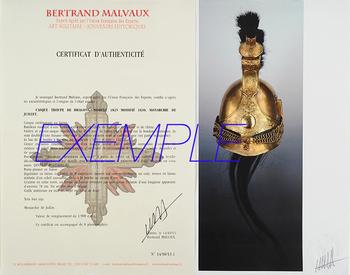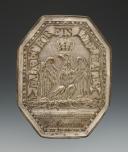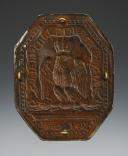
HARNESS PLATE OF IMPERIAL WATERS AND FORESTS OF THE 24th CONSERVATION, model 1805, First Empire. 26041
Sold out
HARNESS PLATE OF IMPERIAL WATERS AND FORESTS OF THE 24th CONSERVATION, model 1805, First Empire. 26041
Octagonal in shape, in silver-plated copper. H 10.3 cm, width 7.9 cm. It bears in its center the crowned imperial eagle holding in its claws the sparkling spindle of Jupiter surmounted by a ribbon bearing the inscription “IMPERIAL WATERS AND FORESTS”. On the lower part, it bears the inscription “24e CONSERV.on” (BELGIUM: Dyle, Jemmape, Escault, Lys, Deux-Nèthes). Complete with its four rear brass mounting brackets.
Signed in the lower part "BOUSSARD"
France.
First Empire.
Very good state
HISTORY:
The decree of the consuls of 6 Pluviôse year IX (January 26, 1801) fixes the number, the district and the residence of the forest agents. In total, France brought back to its pre-1792 borders is divided into 25 conservations, to which are added those of Koblenz for the departments on the left bank of the Rhine and those of the departments of Bouches-du-Rhin and Simplon from of 1810, i.e. a total of 28 preservations.
In 1805, under the First Empire, the term “national forests” was replaced by that of “imperial forests”. The Empire has set up a very present Administration with a strong symbol, that of the eagle, with the words “Waters and forests” on the function plates and on the buttons. These words had been driven out by the Revolution because they were too reminiscent of the Old Regime.
On 7 Thermidor Year XII (July 26, 1805), a decree reformed the general administration of forests. From now on, it becomes a general directorate of the administration, headed by a State Councilor with the title of Director General of the Forest Administration. The general administrator Joseph-Alexandre Bergon, who has become a State Councilor, is appointed Director General of Forests, placed directly under the orders of the Minister of Finance Gaudin (one of the five former general administrators of forests appointed on 2 Pluviôse year IX - January 22, 1801- ), which itself only executes the decisions of the Emperor Napoleon 1st. To help the new Director General who retains the tasks of the 1st Division, a Secretary General is also appointed, the four forest administrators being maintained at the head of their respective divisions until the Restoration.
In May 1806, an imperial decree created twelve posts of General Inspectors of Forestry Administration responsible for making tours throughout the forest territory to control forests and foresters of all grades and to report to the central authorities. Among these Inspectors General there were notably Marcotte, Déliard, Duteil and de Vergennes.
The State hammer, which still retains its round shape and its storage and use rules, changes its imprint to display the Imperial Eagle with the conservation number. The particular hammers of the agents also change: conservators (letter C and conservation number in a hexagonal print), inspectors (letter I and conservation number in a pentagonal print), sub-inspector (letters SI and conservation number in an octagonal imprint), general guard (letters GG and storage number in a round imprint with a maximum diameter of 28 mm), and special guard (letters GP and storage number without determined shape). The surveyor's gavel is a rectangle with cut corners with the letter A and the conservation number as an imprint.
On August 21, 1805, from the Boulogne camp, Napoleon wrote once again to Gaudin about the appointments to the jobs of forest agents. He reminds him that "since curators, inspectors, sub-inspectors and general guards can only enter into the exercise of their functions by virtue of a patent signed by me, in future you must present to me only men capable of carrying out these tasks”39. He also specifies that the private guards will be chosen from among the men who have served and who have shown themselves best. From then on, the Emperor urged the Minister of War to draw up a list of those who combined a suitable education with a certain probity.
The First Empire also marks the first attempt to enlist in the army of the forest service: all those who wanted to integrate the administration of Forests, were required to subscribe to a commitment in the Imperial Guard (Young Guard):
— a two-battalion Imperial Guard flanqueurs-chasseurs regiment was created in 1811, made up of young people aged 18 to 30, sons or nephews of general guards and foot and horse guards from the crown forests and of the domain, and of the forests of the communes of the Empire,
— a regiment of flanqueurs-grenadiers of the Imperial Guard was created in 1813. Originally the sons of imperial guards and forest guards who were recruited, then the nephews or brothers of forest guards.
Under the Empire, Napoleon placed quantities of former “reformed” soldiers in the forest administration.
During the Hundred Days (March - July 1815), Guéheneuc held the position of Director General of Forests, Bergon having retained his position at the start of the Restoration in April 1814, and having resigned upon Napoleon's return in March 1815.
Octagonal in shape, in silver-plated copper. H 10.3 cm, width 7.9 cm. It bears in its center the crowned imperial eagle holding in its claws the sparkling spindle of Jupiter surmounted by a ribbon bearing the inscription “IMPERIAL WATERS AND FORESTS”. On the lower part, it bears the inscription “24e CONSERV.on” (BELGIUM: Dyle, Jemmape, Escault, Lys, Deux-Nèthes). Complete with its four rear brass mounting brackets.
Signed in the lower part "BOUSSARD"
France.
First Empire.
Very good state
HISTORY:
The decree of the consuls of 6 Pluviôse year IX (January 26, 1801) fixes the number, the district and the residence of the forest agents. In total, France brought back to its pre-1792 borders is divided into 25 conservations, to which are added those of Koblenz for the departments on the left bank of the Rhine and those of the departments of Bouches-du-Rhin and Simplon from of 1810, i.e. a total of 28 preservations.
In 1805, under the First Empire, the term “national forests” was replaced by that of “imperial forests”. The Empire has set up a very present Administration with a strong symbol, that of the eagle, with the words “Waters and forests” on the function plates and on the buttons. These words had been driven out by the Revolution because they were too reminiscent of the Old Regime.
On 7 Thermidor Year XII (July 26, 1805), a decree reformed the general administration of forests. From now on, it becomes a general directorate of the administration, headed by a State Councilor with the title of Director General of the Forest Administration. The general administrator Joseph-Alexandre Bergon, who has become a State Councilor, is appointed Director General of Forests, placed directly under the orders of the Minister of Finance Gaudin (one of the five former general administrators of forests appointed on 2 Pluviôse year IX - January 22, 1801- ), which itself only executes the decisions of the Emperor Napoleon 1st. To help the new Director General who retains the tasks of the 1st Division, a Secretary General is also appointed, the four forest administrators being maintained at the head of their respective divisions until the Restoration.
In May 1806, an imperial decree created twelve posts of General Inspectors of Forestry Administration responsible for making tours throughout the forest territory to control forests and foresters of all grades and to report to the central authorities. Among these Inspectors General there were notably Marcotte, Déliard, Duteil and de Vergennes.
The State hammer, which still retains its round shape and its storage and use rules, changes its imprint to display the Imperial Eagle with the conservation number. The particular hammers of the agents also change: conservators (letter C and conservation number in a hexagonal print), inspectors (letter I and conservation number in a pentagonal print), sub-inspector (letters SI and conservation number in an octagonal imprint), general guard (letters GG and storage number in a round imprint with a maximum diameter of 28 mm), and special guard (letters GP and storage number without determined shape). The surveyor's gavel is a rectangle with cut corners with the letter A and the conservation number as an imprint.
On August 21, 1805, from the Boulogne camp, Napoleon wrote once again to Gaudin about the appointments to the jobs of forest agents. He reminds him that "since curators, inspectors, sub-inspectors and general guards can only enter into the exercise of their functions by virtue of a patent signed by me, in future you must present to me only men capable of carrying out these tasks”39. He also specifies that the private guards will be chosen from among the men who have served and who have shown themselves best. From then on, the Emperor urged the Minister of War to draw up a list of those who combined a suitable education with a certain probity.
The First Empire also marks the first attempt to enlist in the army of the forest service: all those who wanted to integrate the administration of Forests, were required to subscribe to a commitment in the Imperial Guard (Young Guard):
— a two-battalion Imperial Guard flanqueurs-chasseurs regiment was created in 1811, made up of young people aged 18 to 30, sons or nephews of general guards and foot and horse guards from the crown forests and of the domain, and of the forests of the communes of the Empire,
— a regiment of flanqueurs-grenadiers of the Imperial Guard was created in 1813. Originally the sons of imperial guards and forest guards who were recruited, then the nephews or brothers of forest guards.
Under the Empire, Napoleon placed quantities of former “reformed” soldiers in the forest administration.
During the Hundred Days (March - July 1815), Guéheneuc held the position of Director General of Forests, Bergon having retained his position at the start of the Restoration in April 1814, and having resigned upon Napoleon's return in March 1815.
Reference :
26041

Next update Friday, april 4th at 1:30 PM
FOR ALL PURCHASES, PAYMENT IN MULTIPLE CHECKS POSSIBLE
bertrand.malvaux@wanadoo.fr 06 07 75 74 63
An authenticity certificate of the item including the description published on the site, the period, the sale price, accompanied by one or more color photographs is automatically provided for any item priced over 130 euros. Below this price, each certificate is charged 5 euros.
Only items sold by me are subject to an authenticity certificate, I do not provide any expert reports for items sold by third parties (colleagues or collectors).

